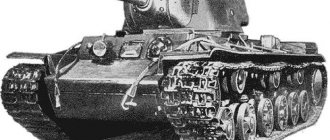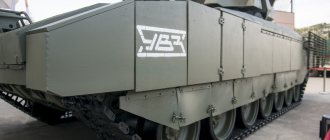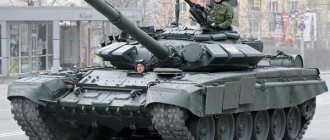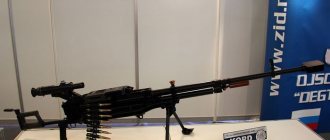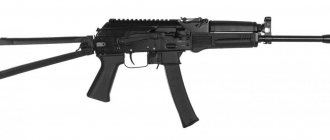General characteristics of T-34E STZ
- Country USSR
- Vehicle type Medium tank
- Rank 2
- Battle rating in arcade mode 4
- realistic mode 4
- simulator mode 3.7
More options
Advanced options
Arcade mode
- Weight 29.5 tons
- Price 77,000€
- Reward 80%
- Research bonus 136%
- Crew training price 22,000€
- Visibility 83%
- Reload time 9.0 s
- 10 free repairs
- Power 775 l. With. at 1800 rpm
- Max. speed 54 km/h
- Climbability 33°
- Repair price 1,160€
- Gun 76 mm F-34 cannon (Ammo: 77) 7.62 mm DT machine gun (Ammo: 2898)
- Turret rotation 23.8°/s
- armor_piercing_100 73 mm
- armor_piercing_500 71 mm
- armor_piercing_1000 65 mm
- Weapon sets 1
- Free repair time 6 hours. 40m.
- Hull (stern) armor 40 mm
- Hull armor (side) 45 mm
- Hull armor (forehead) 60 mm
- Turret armor (stern) 45 mm
- Turret armor (side) 45 mm
- Vert. aiming angles (max) 28°
- Vert. aiming angles (min) -5°
- Turret armor (front) 45 mm
Realistic mode
- Weight 29.5 tons
- Price 77,000€
- Reward 120%
- Research bonus 136%
- Crew training price 22,000€
- Visibility 83%
- Reload time 9.0 s
- 10 free repairs
- Power 442 l. With. at 1800 rpm
- Max. speed 49 km/h
- Climbability 36°
- Repair price 1,260€
- Gun 76 mm F-34 cannon (Ammo: 77) 7.62 mm DT machine gun (Ammo: 2898)
- Turret rotation 14.9°/s
- armor_piercing_100 73 mm
- armor_piercing_500 71 mm
- armor_piercing_1000 65 mm
- Weapon sets 1
- Free repair time 11h. 07m.
- Hull (stern) armor 40 mm
- Hull armor (side) 45 mm
- Hull armor (forehead) 60 mm
- Turret armor (stern) 45 mm
- Turret armor (side) 45 mm
- Vert. aiming angles (max) 28°
- Vert. aiming angles (min) -5°
- Turret armor (front) 45 mm
Simulator mode
- Weight 29.5 tons
- Price 77,000€
- Reward 140%
- Research bonus 136%
- Crew training price 22,000€
- Visibility 83%
- Reload time 9.0 s
- 10 free repairs
- Power 442 l. With. at 1800 rpm
- Max. speed 49 km/h
- Climbability 36°
- Repair price 1,370€
- Gun 76 mm F-34 cannon (Ammo: 77) 7.62 mm DT machine gun (Ammo: 2898)
- Turret rotation 14.9°/s
- armor_piercing_100 73 mm
- armor_piercing_500 71 mm
- armor_piercing_1000 65 mm
- Weapon sets 1
- Free repair time 11h. 08m.
- Hull (stern) armor 40 mm
- Hull armor (side) 45 mm
- Hull armor (forehead) 60 mm
- Turret armor (stern) 45 mm
- Turret armor (side) 45 mm
- Vert. aiming angles (max) 28°
- Vert. aiming angles (min) -5°
- Turret armor (front) 45 mm
Statistics on T-34E STZ for 1 month
These statistics are collected on players who visited our site and cannot be used to point out problems to developers, as they are not complete. Arcade mode
- Number of battles 4045
- Win rate 64.15%
- Air frags per battle 0.01
- Air frags per death 0.05
- Ground frags per battle 2.4
- Ground frags per death 2.89
Realistic mode
- Number of battles 2830
- Win percentage 62.89%
- Air frags per battle N/A
- Air frags per death N/A
- Ground frags per battle 2.35
- Ground frags per death 2.06
Simulator mode
- Number of battles 10
- Win percentage N/A
- Air frags per battle N/A
- Air frags per death N/A
- Ground frags per battle N/A
- Ground frags per death N/A
Videos about T-34E STZ
CrewGTW T-34E STZ ONE LEAF in War Thunder
CrewGTW T-34E STZ BUTT FEEDER in War Thunder
Cross T-34E STZ | As easy as shelling pears | War Thunder
Psiche WarThunder T-34E STZ + T-34 1942 = 23 tanks
Yuriy S War Thunder KV-1E, T-34E, T-34-STZ
Omero Review of T-34E STZ: The blow holds | Realistic fights | War Thunder
Ros Dolg Still in action in War Thunder! Arcade review of the T-34E STZ.
Freeman Project Var Thunder - SCREENED MIRACLE T-34 E
RainbowSeven War Thunder Platoon – Episode 55 – Battle – Berlin (RB) – T-34E STZ, T-34 1941
RainbowSeven War Thunder – Series 42 – AB – Capture – Jungle – Destroyer – T-34 1941, T-34E STZ, T-34 1942
RainbowSeven War Thunder Platoon – Episode 54 – Battle – Berlin (RB) – T-34E STZ
RainbowSeven War Thunder – Episode 26 – RB – T-34E STZ – No deaths – Supremacy – Hürtgen Forest
History of the creation of the T-34. Part 6. Stalingrad Tractor Plant.
This part will be devoted to the production of T-34 tanks at plant No. 174 in the city of Stalingrad.
The production of T-34 tanks at the Stalingrad Tractor Plant (STZ) differed from the production of the same vehicles at other enterprises. Production of the T-34 at STZ began immediately after it was put into service, but in the fall of 1941, plant No. 174 became the only manufacturer of the T-34 and remained so until the end of the summer of 1942, when the front passed through the plant’s workshops. The Stalingrad Tractor Plant is the only plant in the USSR that was not evacuated during the Great Patriotic War, but completely ceased to exist.
History of the creation of the T-34. Part 6. Stalingrad tractor class=”aligncenter” width=”1016″ height=”657″[/img]The history of the creation of the T-34. Part 6. Stalingrad Tractor Plant.
A column of tanks produced by STZ in early 1942.
Back on December 19, 1939, by resolution No. 442 of the USSR Defense Committee, it was obligated to organize the production of T-34 tanks at STZ and to stop preparing the production of T-26 tanks. The basic drawings for the production of the "thirty-four" were supposed to be sent to STZ in February 1940. But due to the heavy workload of expanding production of the T-34, Kharkov plant No. 183 was unable to send documents until the end of April 1940, and even then not in full - 1,400 drawings out of 3,500 required. Nevertheless, work on the production of parts for the pilot batch began. On May 13, 1940, the armored department forbade STZ to make changes to the parts, components and design of the T-34 tank and decided to coordinate any changes with plant No. 183 and ABTU.
The Stalingrad plant received the first hull of the "thirty-four" from Kharkov only at the beginning of June 1940, and on June 16 the first tank was assembled. However, after the factory run-in, a number of defects were discovered, which took about 15 days to eliminate. Despite the large amount of work done, the plant failed to fulfill the ABTU task of producing tanks by October 1940, which was reported to the GABTU. In November 1940, the plant managed to assemble only six tanks, two of which passed factory tests. In total, in 1940, 23 T-34 tanks were assembled at STZ, of which only six vehicles passed acceptance.
History of the creation of the T-34. Part 6. Stalingrad Tractor Plant.
History of the creation of the T-34. Part 6. Stalingrad Tractor Plant.
Tank T-34 produced by STZ in Medyn, Moscow region.
The plan for 1941 provided for a sharp increase in T-34 production: by the end of the year the plant was supposed to produce 1000 tanks. To ensure the implementation of this plan, new complete sets of drawings and technological maps were delivered to Stalingrad from plant No. 183. In addition, 5 engineers came to the plant from Kharkov to assist in organizing the production of the T-34 tank. All this led to a correction of the situation: in March 1941, STZ had already produced 47 tanks, and since the beginning of the year - 75 vehicles. On March 4, 1941, 30 T-34 tanks were sent to the 12th Tank Division of the Kyiv Special Military District.
After the start of the war, the tank production plan at STZ increased to 1,500 vehicles. To ensure this plan, the production of non-military products at the plant was sharply reduced. In June 1941, 86 tanks were received.
History of the creation of the T-34. Part 6. Stalingrad Tractor Plant.
History of the creation of the T-34. Part 6. Stalingrad Tractor Plant.
T-34 tank produced by STZ on the march.
Back in 1940, the Stalingrad Shipyard in Sarepta (plant No. 264) received the task of developing and manufacturing the hulls and turrets of the T-34 tank, but the company did nothing in this direction. The first hulls and turrets were assembled in Sarepta only in April 1941, only 3 sets. In July 1941, Plant No. 264 transferred 28 sets of hulls and turrets to STZ, but this was clearly not enough to organize full-scale production of T-34 tanks in Stalingrad.
In addition to the problem with components, STZ also had a problem with personnel: many workers, including highly qualified specialists, were drafted into the army. Nevertheless, the production of T-34 tanks in Stalingrad increased. In July 1941, 93 vehicles were accepted, and in August - 155. However, already in October 1941, production fell: only 124 tanks were delivered.
This was due to the evacuation of Kharkov factories No. 183 and 75, which supplied armored hulls and B-2 diesel engines to Stalingrad. To somehow rectify the situation, STZ began its own production of diesel engines, but in small volumes. A solution was found in the use of carburetor engines M-17T and M-17F. The catch was that the M-17 engine was no longer mass-produced. Equipping the "thirty-four" with carburetor engines worsened the combat characteristics of the tanks, but this did not allow them to reduce their production. In total, in 1941, the Stalingrad Tractor Plant delivered 1,250 T-34 tanks.
From October 1941 until the spring of 1942, STZ was the only enterprise that produced T-34 in significant quantities.
History of the creation of the T-34. Part 6. Stalingrad Tractor Plant.
History of the creation of the T-34. Part 6. Stalingrad Tractor Plant.
Preparing T-34 tanks produced by STZ for sending to the front. Summer 1942.
At the end of October 1941, the T-34 STZ was equipped with cast road wheels with internal shock absorption, which made it possible to increase production and save rubber, which was sorely in short supply. Later, tires from STZ-5 tractors began to be used as a rubber buffer on rollers, fortunately there were a large number of them at the plant. This decision made it possible to improve the quality of the rollers, since the tires were made from pre-war natural rubber.
Another major innovation at STZ was the changed technology for the production of armored hulls and turrets. The essence of the new method was that in the manufacture of armored structures such complex operations as gouging and milling of the edges of armor plates were abandoned and the use of their connection into a “tenon” was proposed. After assembling the tower, it was hardened in assembled form, after which editing was absolutely not required.
History of the creation of the T-34. Part 6. Stalingrad Tractor Plant.
History of the creation of the T-34. Part 6. Stalingrad Tractor Plant.
The rear part of the hull of the T-34 tank, manufactured using a new technology for connecting parts into a “spike” during testing.
In January 1942, STZ achieved significant success in engine building, producing 225 V-2 diesel engines in a month.
A real disaster for STZ were cracks in the armored parts that were manufactured by plant No. 264. Many defects were found on completely new vehicles. The audit found that plant No. 264 produced armored hulls with cracks: in January - 51%, in February - 60%, in March - 68%. The main causes of defects in tanks and armored hulls were:
1. Violation of technology and design in the manufacture of gearbox housings.
2. Introduction of an untested, inferior final drive mounting design.
3. Violation of heat treatment and introduction of an untested substitute to the final drive driven shafts.
4. Extremely low technological discipline and insufficient control of the STZ quality control department over the assembly and manufacture of tanks.
5. Lack of control of welding modes and gaps when welding housings from plant No. 264.
History of the creation of the T-34. Part 6. Stalingrad Tractor Plant.
History of the creation of the T-34. Part 6. Stalingrad Tractor Plant.
A column of new T-34s in the yard of the STZ before being sent to the front.
July 1942 marked the peak of production of T-34 tanks at the Stalingrad plant: 421 tanks were delivered. But this came at a very high price: in a number of parts, instead of aluminum, bronze and brass, which were in short supply, it was necessary to use steel or cast iron; instead of copper tubes, steel ones appeared; tinning of fuel and oil tanks was canceled. By the end of July, a decision was made to simplify the design of the T-34 STZ tanks. And despite the difficult conditions, the bombing that had begun and the lack of materials, the plant still supplied tanks to the front, which was almost close to Stalingrad.
On August 23, German tanks were only one and a half kilometers from the Stalingrad Tractor Plant. After the report of the head of the STZ air defense Malyshev to the front headquarters about the current situation, the plant was instructed to prepare all the tanks that could move and fire from those available in the workshops. They were crewed mainly by factory workers. Within a few hours, about 50 Thirty-Fours left the STZ workshops for battle.
On August 25, 1942, martial law was declared in Stalingrad; by this time, production of T-34 tanks had actually ceased. Thus, the Stalingrad Tractor Plant produced 2394 T-34 tanks.
